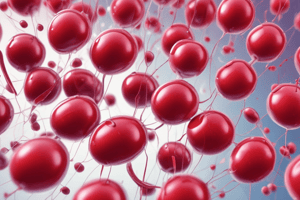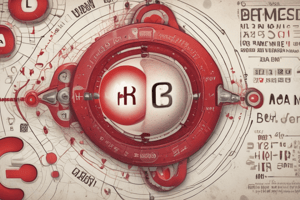Podcast
Questions and Answers
What is the primary function of the respiratory system?
What is the primary function of the respiratory system?
- To digest food into smaller molecules
- To pump blood throughout the body
- To bring oxygen into the body and remove carbon dioxide (correct)
- To filter waste from the blood
Which of the following is NOT a main blood group?
Which of the following is NOT a main blood group?
- A
- AB
- XY (correct)
- B
What happens to the air during inhalation?
What happens to the air during inhalation?
- It is digested in the stomach
- It enters the lungs through the mouth or nose (correct)
- It is absorbed into the bloodstream
- It is exhaled out of the lungs
What is the role of the diaphragm in the process of breathing?
What is the role of the diaphragm in the process of breathing?
What is the significance of the Rh antigen in blood groups?
What is the significance of the Rh antigen in blood groups?
What is the function of the heart in the circulatory system?
What is the function of the heart in the circulatory system?
What is the primary function of the digestive system?
What is the primary function of the digestive system?
What is the role of the diaphragm during exhalation?
What is the role of the diaphragm during exhalation?
What is the function of the mitochondria in a cell?
What is the function of the mitochondria in a cell?
What is the role of capillaries in the circulatory system?
What is the role of capillaries in the circulatory system?
Flashcards are hidden until you start studying
Study Notes
Blood Groups
- There are four main blood groups: A, B, AB, and O
- These groups are determined by the presence or absence of specific antigens on the surface of red blood cells
- Each blood group can be further classified as Rh positive or Rh negative, depending on the presence of the Rh antigen
- Blood groups are important for blood transfusions, as incompatible blood can cause an immune response
Respiratory System
- The respiratory system is responsible for bringing oxygen into the body and removing carbon dioxide
- The main organs of the respiratory system are the lungs, trachea, bronchi, and diaphragm
- The process of breathing involves:
- Inhalation: air enters the lungs through the mouth or nose
- Diaphragm contraction: the diaphragm contracts, increasing the volume of the chest cavity
- Air enters the lungs: air enters the lungs through the bronchi and bronchioles
- Oxygen absorption: oxygen diffuses into the bloodstream through the alveoli
- Exhalation: the diaphragm relaxes, and air is pushed out of the lungs
Circulatory System
- The circulatory system is responsible for transporting oxygen and nutrients to cells and removing waste products
- The main organs of the circulatory system are the heart, arteries, veins, and blood vessels
- The heart is a muscular organ that pumps blood throughout the body
- Blood vessels:
- Arteries: carry oxygenated blood away from the heart
- Veins: carry deoxygenated blood back to the heart
- Capillaries: allow for the exchange of oxygen and nutrients with cells
Digestive System
- The digestive system is responsible for breaking down food into nutrients that can be absorbed and used by the body
- The main organs of the digestive system are the mouth, esophagus, stomach, small intestine, and large intestine
- The process of digestion involves:
- Ingestion: food enters the mouth
- Mechanical digestion: food is broken down into smaller pieces by teeth and muscles
- Chemical digestion: enzymes break down food into nutrients
- Absorption: nutrients are absorbed into the bloodstream through the walls of the small intestine
- Elimination: waste products are eliminated from the body through the anus
Cell Structure
- A cell is the basic unit of life, consisting of:
- Plasma membrane: a thin layer of lipid and protein molecules that surrounds the cell
- Cytoplasm: a gel-like substance inside the cell where metabolic processes take place
- Nucleus: contains the cell's genetic material (DNA)
- Mitochondria: responsible for generating energy for the cell
- Endoplasmic reticulum: involved in protein synthesis and transport
- Lysosomes: contain digestive enzymes that break down and recycle cellular waste
- Ribosomes: site of protein synthesis
Blood Groups
- Four main blood groups exist: A, B, AB, and O, determined by specific antigens on red blood cell surfaces
- Each group can be Rh positive or Rh negative, depending on the presence of the Rh antigen
- Blood groups are crucial for blood transfusions to avoid immune responses from incompatible blood
Respiratory System
- Responsible for bringing oxygen into the body and removing carbon dioxide
- Main organs: lungs, trachea, bronchi, and diaphragm
- Breathing process:
- Inhalation: air enters lungs through mouth or nose
- Diaphragm contraction: increasing chest cavity volume
- Air enters lungs: through bronchi and bronchioles
- Oxygen absorption: through alveoli into the bloodstream
- Exhalation: diaphragm relaxation, air pushed out of lungs
Circulatory System
- Responsible for transporting oxygen and nutrients to cells and removing waste products
- Main organs: heart, arteries, veins, and blood vessels
- Heart: a muscular organ that pumps blood throughout the body
- Blood vessels:
- Arteries: carry oxygenated blood away from the heart
- Veins: carry deoxygenated blood back to the heart
- Capillaries: allow for oxygen and nutrient exchange with cells
Digestive System
- Responsible for breaking down food into absorbable nutrients
- Main organs: mouth, esophagus, stomach, small intestine, and large intestine
- Digestion process:
- Ingestion: food enters the mouth
- Mechanical digestion: food broken down by teeth and muscles
- Chemical digestion: enzymes break down food into nutrients
- Absorption: nutrients absorbed into the bloodstream through the small intestine
- Elimination: waste products eliminated through the anus
Cell Structure
- A cell is the basic unit of life, consisting of:
- Plasma membrane: a thin layer of lipid and protein molecules surrounding the cell
- Cytoplasm: a gel-like substance inside the cell where metabolic processes take place
- Nucleus: contains the cell's genetic material (DNA)
- Mitochondria: responsible for generating energy for the cell
- Endoplasmic reticulum: involved in protein synthesis and transport
- Lysosomes: contain digestive enzymes that break down and recycle cellular waste
- Ribosomes: site of protein synthesis
Studying That Suits You
Use AI to generate personalized quizzes and flashcards to suit your learning preferences.




